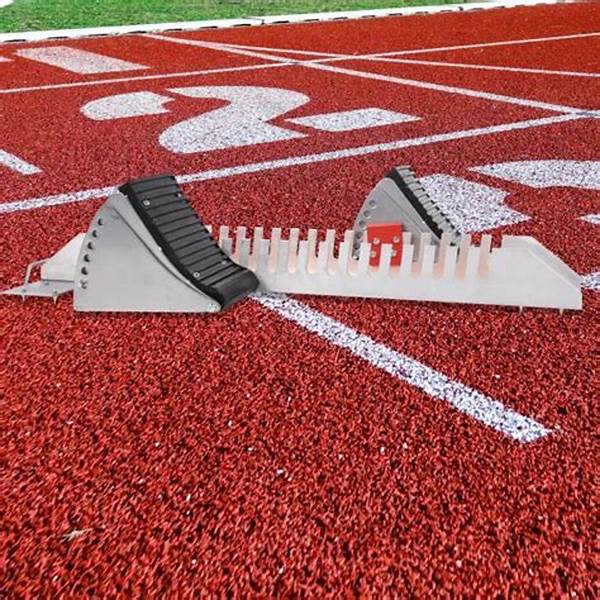The Function Of Starting Blocks In Sprinting

In the electrifying world of track and field, where milliseconds can mean the difference between victory and defeat, the role of starting blocks in sprinting cannot be overstated. Imagine the Olympic Games—an arena where the world’s fastest athletes converge, each one vying for gold. As the camera zooms in on the sprinters, tension is palpable, and the crowd holds its collective breath. What happens next is crucial: the explosive start. Herein lies the secret weapon; starting blocks, a seemingly simple, yet indispensable tool in the arsenal of any sprinter.
Read More : Why Aerodynamics Matter In Cyclists
Starting blocks are more than just launchpads; they are a fusion of engineering and human potential designed to propel sprinters into action. As the starter gun signals, the correct use of these blocks can be a game-changer, giving athletes the initial momentum needed to dominate the track. Whether you’re an aspiring high school athlete or a seasoned professional, understanding the function of starting blocks in sprinting offers insights into the mechanics and strategy that define victories and record-breaking performances.
Understanding the Function of Starting Blocks
While the significance of starting blocks is evident at first glance, a deeper dive reveals their true impact. They’re not just pieces of equipment; they embody a philosophy that merges physics with human kinetics. The function of starting blocks in sprinting revolves around optimizing the body’s position for powerful leg drive, ensuring a rapid transition from static to dynamic motion.
Generating Optimal Force
One of the primary functions of starting blocks is to allow athletes to generate maximum force. By providing a stable platform for the feet, blocks enable sprinters to push against a solid surface, translating potential energy into kinetic energy. This action propels the athlete forward with remarkable acceleration. In fact, studies have shown that an effective start can contribute significantly to a sprinter’s finishing time.
Enhancing Reaction Time
Reaction times are critical in competitive sprinting, often amounting to mere fractions of a second. The function of starting blocks in sprinting extends to offering a consistent and reliable point of resistance for athletes to initiate their start. Consequently, this consistency aids in reducing reaction times as athletes are able to mentally and physically prepare for the explosive takeoff.
Ensuring Body Alignment
Proper body alignment at the starting line is vital for achieving peak performance. This involves positioning the body at an angle that maximizes efficiency and speed. Starting blocks ensure that sprinters’ feet are correctly aligned, promoting optimal body posture upon launch. This alignment minimizes energy wastage and reduces the risk of losing balance during the initial moments of the race.
Technical Aspects of Starting Blocks
Understanding the technicalities behind starting blocks is crucial for athletes and coaches wanting to leverage their benefits fully.
Adjustable Features
Starting blocks are not one-size-fits-all tools. Athletes can adjust them to suit their individual preferences, adjusting the angle and distance of the blocks to optimize their starting stance. This customization can significantly impact performance, allowing athletes to tailor the blocks to their specific biomechanical needs.
Material and Design
Constructed from lightweight, durable materials, starting blocks are designed to withstand the immense forces generated during sprints. The blocks’ non-slip surfaces ensure stability, while their aerodynamic design minimizes drag, facilitating smoother transitions from blocks to track.
Coaching Perspectives
Coaches play a vital role in helping athletes master the use of starting blocks. Through video analysis and biomechanical assessments, coaches can provide insights into the most efficient techniques for using these vital tools. By refining these details, athletes can shave precious milliseconds off their times.
Read More : Sky Sports Offers Fast Real-time Football Results
Unlocking Peak Performance with Starting Blocks
In competitive sprinting, every detail counts, and starting blocks represent a nexus of technology and athletic prowess. The function of starting blocks in sprinting, though often overlooked by casual observers, is integral to athletic success. Whether it’s young athletes learning to harness their power or seasoned professionals refining their form, the impact of effective block use is universal.
The Science Behind the Function of Starting Blocks
Let’s delve into the physiology and biomechanics that make starting blocks so effective.
Physics in Action
The initial force applied to the starting blocks propels the sprinter forward into an optimal running posture, setting the foundation for speed. The kinetic friction between the sprinter’s shoes and the track, combined with the block’s stability, enables an explosive start crucial for quick acceleration.
Psychological Advantage
Starting blocks not only serve a physical purpose but also instill confidence. Sprinters develop a psychological edge knowing they have a reliable and consistent method to maximize propulsion at the start. This mental aspect can be the deciding factor in high-stakes races.
Athlete Testimonials
Many elite athletes credit starting blocks as pivotal to their success. Usain Bolt, the fastest man on Earth, often speaks about the necessity of perfecting his start to dominate races. This testimony underscores that even the greats rely on the fundamentals delivered by starting blocks.
Conclusion
In a sport where every fraction of a second is scrutinized, the function of starting blocks in sprinting rises to prominence. They are a testament to how simple tools, when mastered, can transform potential into unmatched performance. Whether you’re a coach, an athlete, or a fan, recognizing the integral role of these blocks enriches your appreciation of the sport. Unlock your potential by mastering the art and science of starting blocks, and witness how these formidable tools can elevate your sprinting prowess.



